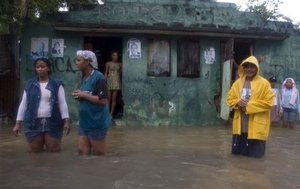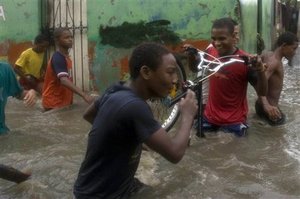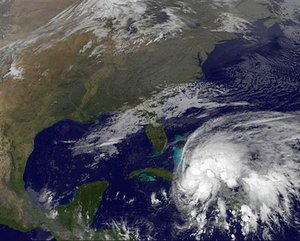The storm was slowly moving away from the north coast of Cuba and was projected to skirt Florida and batter the Bahamas, the U.S. National Hurricane Center said. A tropical storm watch was issued for parts of southeast Florida.
With rain still falling two days after the storm hit, rescuers were struggling to reach communities cut off by flooding on the island of Hispaniola. As they did, they found a rising toll of death and damage - at least 56 dead in the Dominican Republic, 24 in Haiti and one in Jamaica.
A swollen river overflowed its banks Monday night and swept away the hamlet of Piedra Blanca in the central Dominican Republic, forcing Charo Vidal to climb a tree. She watched her neighbor struggle to do the same nearby, clutching infant twins while water swept an older daughter away.
"She couldn't take care of all three," Vidal said Wednesday. "That is something very significant, to have a child snatched from your hands and you cannot do anything for them."
The mother, Mary De Leon, was inconsolable. "The river tore her from my hands as I held her," she said through tears.

|
| ©AP Photo/Ramon Espinosa |
| People stand in a flooded street of Santo Domingo, Wednesday, Oct. 31, 2007. |
"A lot of people had to choose between losing one child and losing another one," said Liony Batista, a project manager for Food for the Poor, an international Christian relief organization.
Sagrario Diaz, a 42-year-old farmer, also struggled to hold on to his son in the surging waters but failed. "I fought, I swear I tried to save him, but I couldn't," Diaz said. "I would like to die."
A neighbor, Lucia Araujo, said she heard the boy scream: "Daddy, I don't want to drown. Help me, I don't want to drown."
At least seven people died in Piedra Blanca, emergency officials said.
About 200 homes were destroyed in the nearby town of Bonao, Batista said.
Dominican President Leonel Fernandez declared a state of emergency for the next 30 days and asked for international help, especially rescue teams and helicopters. He ordered residents in 36 communities to evacuate because they were in potential flood zones.
At least 58,300 Dominicans fled their homes, some 14,500 of which were damaged, said Luis Antonio Luna, head of the Emergencies Commission. He said at least 56 people had died in the Dominican Republic so far. Flooding also forced the evacuation of about 1,000 inmates from a prison north of the Dominican capital.
Luna said officials were trying to reach dozens of isolated communities, but bad weather, a lack of helicopters and damage to bridges and highways slowed rescue efforts.
The southwestern town of San Jose de Ocoa was in a precarious situation, unreachable by air, land or water, Public Works Secretary Victor Diaz Rua said.
"We have been told that the town has a limited food supply, so we're looking for a way in," Diaz said.
In neighboring Haiti, floods rushed through houses in the capital's Cite Soleil slum, carrying away a 3-year-old boy as relatives frantically shouted for help and tried unsuccessfully to reach him through the muddy, debris-filled water.
Two people were killed when their house collapsed in a mudslide in the hillside suburb of Petionville, and at least three others died in Jacmel, where officials said 150 people were trapped on rooftops awaiting aid.

|
| ©AP Photo/Ramon Espinosa |
| Residents struggle to cross a flooded street of Santo Domingo, Wednesday, Oct. 31, 2007. |
Some Haitian shelters were overwhelmed by evacuees. One in Cite Soleil, guarded by U.N. troops, had one blanket for every two people.
Noel is the deadliest storm in this part of the Caribbean since Tropical Storm Jeanne hit Haiti in 2004, triggering floods and mudslides that killed an estimated 3,000 people.
For the Atlantic region as a whole, Noel is the second deadliest of the 2007 season. Hurricane Felix, a monster Category 5 storm, killed at least 101 people in early September, mostly along the Caribbean coast of Nicaragua and Honduras.
At 8 p.m. EDT, Noel was centered about 160 miles south-southwest of Nassau, Bahamas, and about 230 miles south-southeast of Miami. Forecasters said the storm had maximum sustained winds of nearly 60 mph and some strengthening was possible during the next 24 hours.
Eastern Cuba got soaked but apparently escaped major damage.
Rough surf warnings were in effect for much of South Florida. Waves were pounding beaches in the Miami area, and residents of a waterfront condominium in South Palm Beach were urged to evacuate after pounding surf destroyed a retaining wall damaged this month in another storm.
The tropical storm watch was issued for about a 140-mile stretch of Florida from just north of the Keys to Jupiter. Meanwhile, wind and waves washed out beaches from the Georgia border to Miami.
In Andros Island, the Bahamian chain's largest, boatowners tied their vessels down and residents secured loose items around their properties as Noel trekked toward the storm-hardened archipelago southeast of Florida.
Michael Stubbs, a government meteorologist, said Noel was expected to be close to hurricane strength when spinning west of northwest Andros Island at about dawn Thursday. It was forecast to veer east, away from the United States, after churning past the northeast Bahamian island of Abaco.
Associated Press writers Danica Coto in San Juan, Puerto Rico, Ramon Almanzar in Santo Domingo, Dominican Republic, Jonathan M. Katz in Port-au-Prince, Haiti, Will Weissert in Havana and Jessica Robertson in Nassau, Bahamas, contributed to this report.




Reader Comments
to our Newsletter